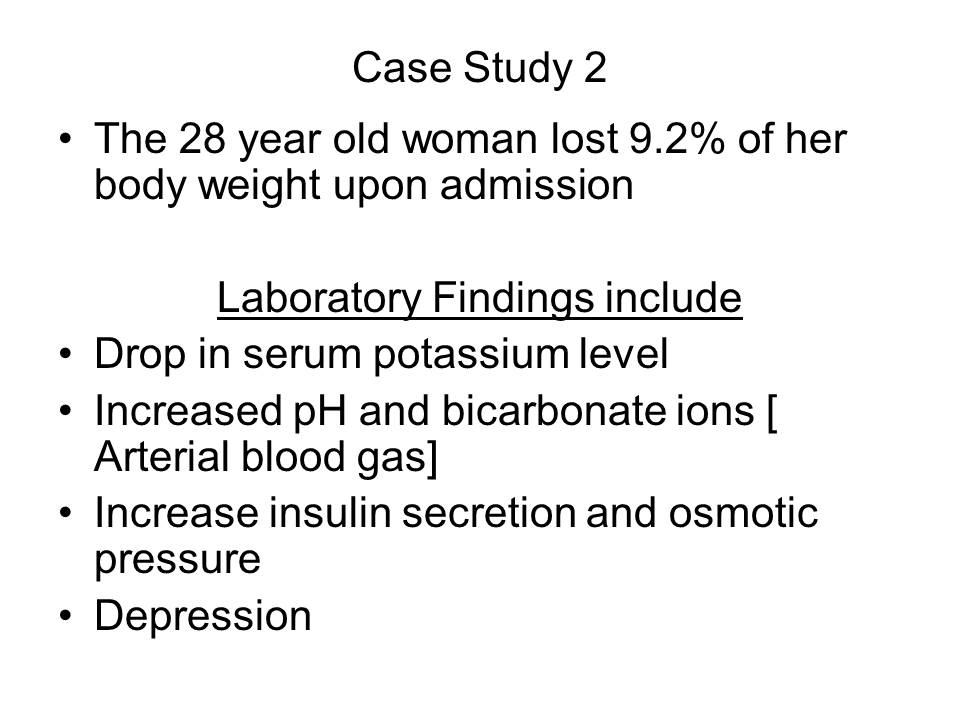Sodium (Na++)
Physiological roles of Sodium
- Sodium helps to transmit nerve impulses
- Sodium assists in the osmolality of vascular fluids
The combination of sodium with chlorides or bicarbonate helps to regulate Acid -base balance.
- Sodium is responsible in maintaining water balance.
- Sodium is responsible for ECF volume.
Sodium Imbalance occurs when:
- There is a change in the sodium volume of the ECF
- There is a change in the chloride content
- There is a change in the quantity of water in the ECF
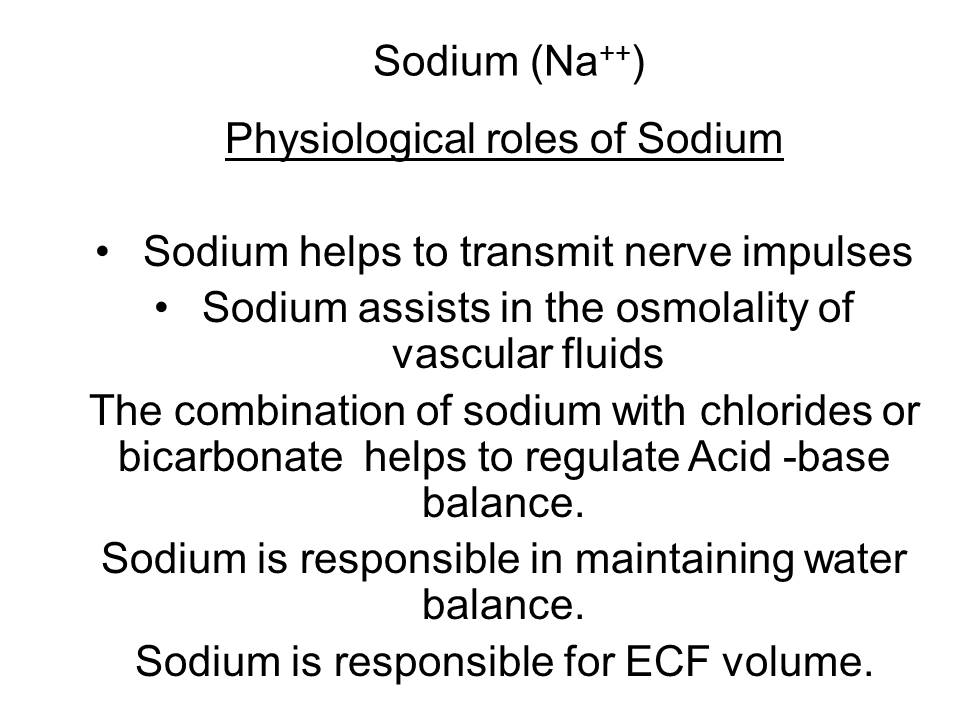
Effects of Serum Sodium Deficit
Hyponatremia
- Hyponatremia is a condition that occurs when the serum sodium level falls below normal [ that is less that 135nEq/L], so it occurs when there is High amount of water or reduction in sodium content. Sodium deficits are related to Hypervolemia conditions.
- Hyponatremia can also occur when there is an abnormal loss of gastrointestinal secretions.
- It also occurs when excessive sweating results in high volume of water consumption.
- Labor induction in women with Oxytocin can cause the reduction of sodium volume thereby, causing a dilutional Hyponatremia
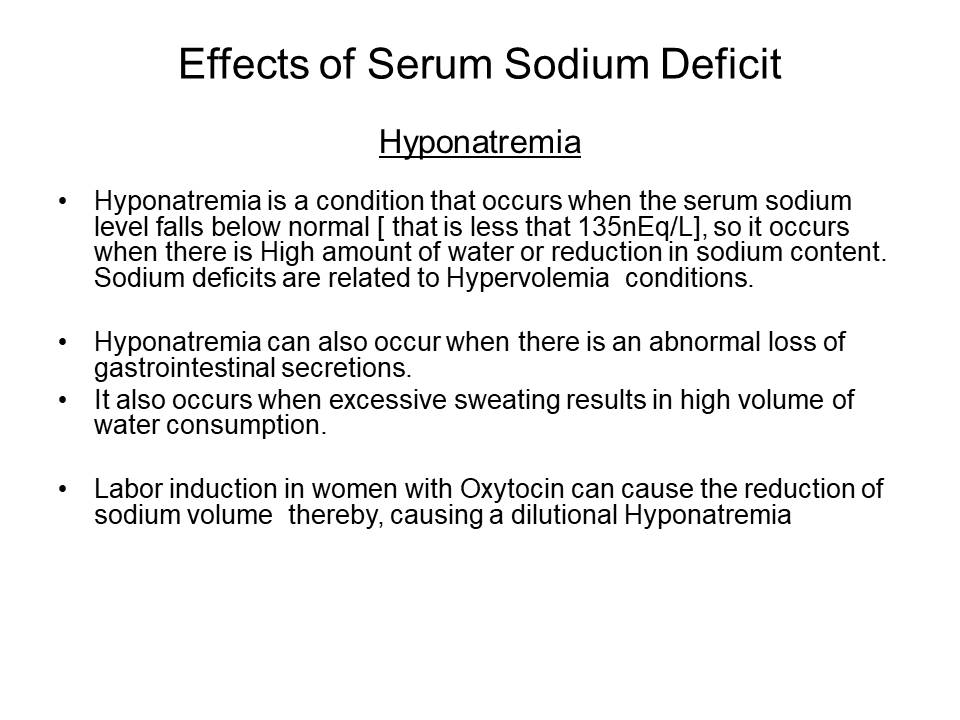
Clinical Manifestations of Hyponatremia
Hyponatremia affects cells of the central nervous system, thus patients will experience:
- Impaired sensation of taste
- Muscle cramps
- Anorexia
- Anxiety
- Exhaustion
- Weakness
Treatment and Management of Hyponatremia
Patients can be treated using:
- Diets [ for those that can eat and drink]
- Parenteral routes [ patients unable to eat will have to take the electrolytes]
- Note that this treatment aims at replacing lost sodium
- Restoring the ECF volume to normal
- Correcting other losses in electrolytes
- Carefully examine laboratory test with emphasis on serum sodium
- Examine GI losses
- Monitor the intake , output plus daily weight of the patients
- Examine the signs and symptoms of Hyponatremia
- Restrict water intake.
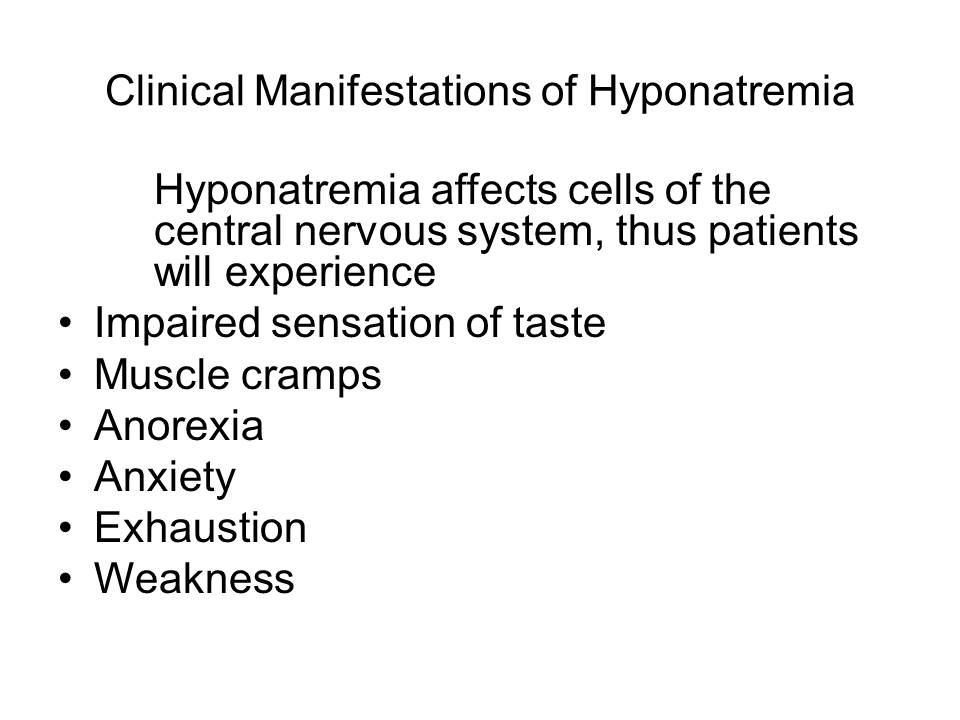
Effects of Serum Sodium Excess
Hypernatremia
- Hypernatremia occurs when there is an elevation of serum sodium volume and a loss of water content
- Clinical Manifestations of Hypernatremia
- Patients’ experiences marked thirst
- High body temperature
- Swollen tongue
- Red, dry and sticky mucous membrane.
Treatment and Management of Hypernatremia
- The aim of this treatment is to lower the serum sodium content
- This can be achieved by infusion of a hypotonic electrolyte solution
- The use of diuretics
- The administration of Desmopressin acetate
- Discontinuing any medication that may be the cause of this elevated sodium content

Potassium (K+)
- Potassium is an intracellular electrolyte with 98% in the ICF and 2% in the ECF it is acquired through diet.
- Potassium helps to regulate fluid volume in the cell
- It promotes nerve impulse transmissions
- Potassium controls the hydrogen ion balance
- Potassium plays a part in the enzyme action of cellular energy production.
- Influences skeletal and cardiac muscle activity
- Potassium imbalance can occur when there is either an increase or decrease in the volume of serum potassium
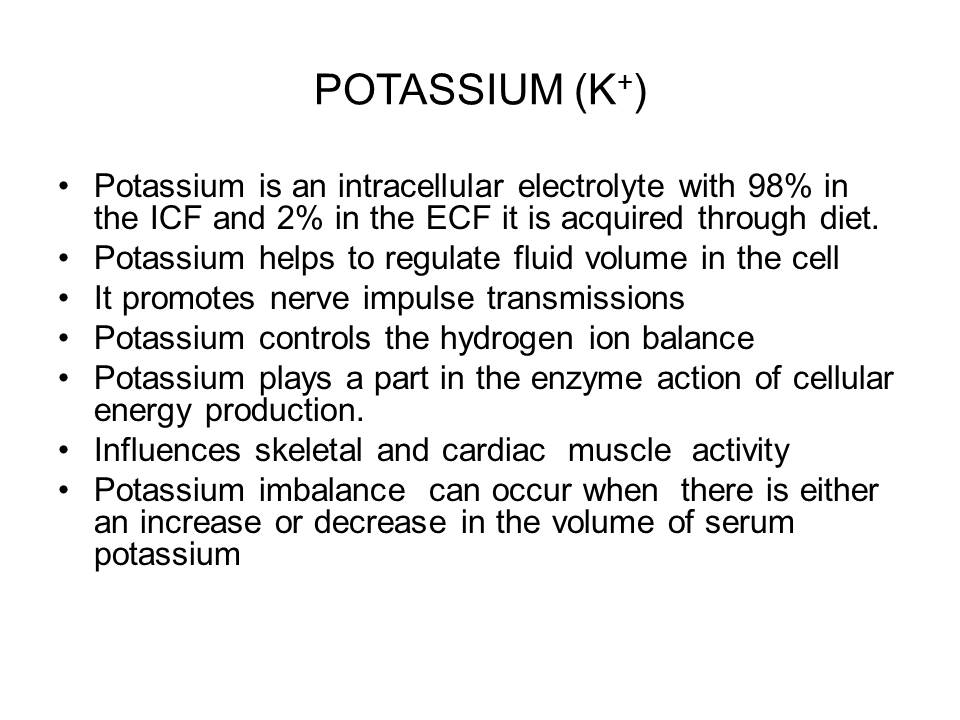
Effects of potassium deficit [Hypokalemia]
- When the potassium level drops below 3.5mEq/L
- Excessive sweating
- Gastrointestinal loss due to laxative overuse or prolonged gastric suction
Clinical Manifestations
- Patients suffer weakness
- Diminished tendon reflexes
- Flaction paralysis
- Vomiting
- Increased sensibility to digitals
- Cardiac arrest
Treatment and Management of Hypokalemia
- This treatment must be administered slowly to watch for dysrhythmias
- Potassium replacement can be by mouth or intravenous.
- Salt substitutes can be used
- Never give a potassium I.V. push/Bolus.
- Make sure the test results are carefully examined
- Monitor signs and symptoms of hypokalemia
- Monitor changes in cardiac arrest
![Effects of potassium deficit [Hypokalemia]](https://ivypanda.com/essays/wp-content/uploads/2022/06/fundamentals-of-fluids-and-electrolytes-balance-slide-6.jpg)
Effect of Potassium Excess [Hyperkalemia]
- Occurs less frequent. But more deadly than Hypokalemia. it is a function of excess serum potassium
Causes of Hyperkalemia
- It is caused by an increase in the volume of serum potassium
- It occurs when there is a decrease of urinary excretion of potassium
- It is caused by the movement of potassium out of the cells into extracellular space.
- Some drugs can predispose an individual to hyperkalemia , these drugs include potassium penicillin, beta blockers, amphetamines
Clinical Manifestations
- Irregular pulse
- Vague muscle weakness
- Paralysis
- Anxiety
- Cramping
- Nausea
Treatment / Management
- The aim of treatment is to return the serum potassium to the normal level while treating the cause.
- Stop the intake of potassium
- Discontinues supplements of potassium
- Introduction of cation – exchange resins
- Dialysis may be ordered
- Glucose and insulin should be administered to facilitate movement of potassium
![Effect of Potassium Excess [Hyperkalemia]](https://ivypanda.com/essays/wp-content/uploads/2022/06/fundamentals-of-fluids-and-electrolytes-balance-slide-7.jpg)
Calcium (CA++)
Physiological Roles of calcium include:
- Maintaining skeletal elements for strong bones and teeth
- Regulates neuromuscular activity
- Influences enzyme activity
- Calcium helps in holding the cells together
- Calcium is present in three forms
- Ionized calcium, bound calcium and complex calcium
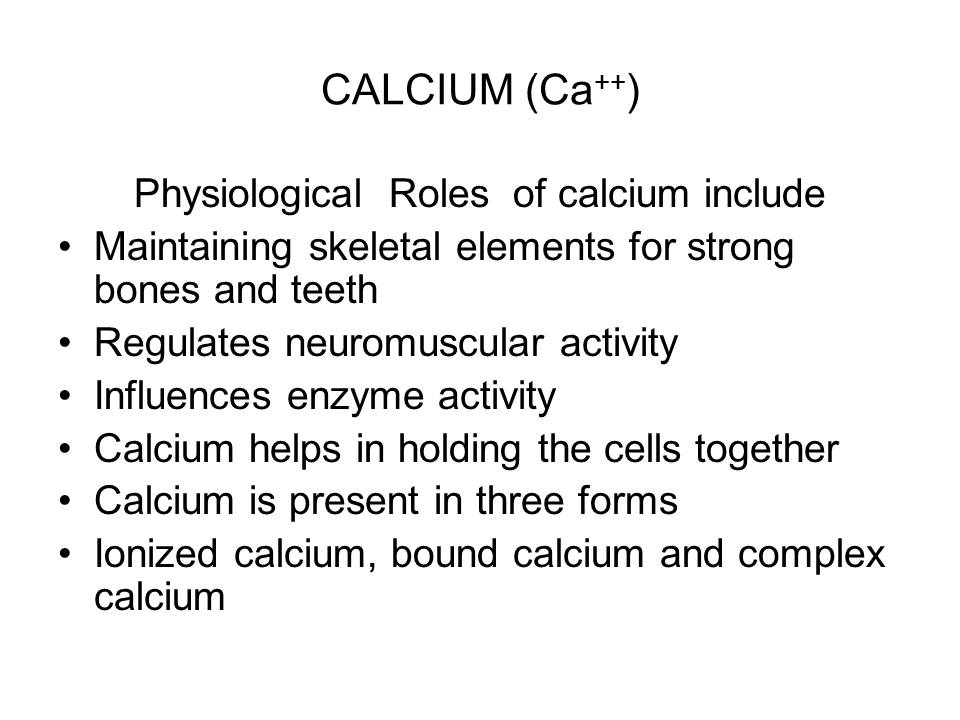
Effects of Serum Calcium deficit [Hypocalcaemia]
- Hypocalcaemia occurs when serum is low
- It is caused by inadequate secretion of PTH
- It can also result from calcium loss through diarrhea
- It can also result from radiographic contrast media
Clinical Manifestations
- Patients with hypocalcaemia show symptoms of neuromuscular such as numbness
- Cramps
- Deep tendon reflexes
- Deep irritability
- Memory impairment
- Development of laryngospasm and tetany contractions
![Effects of Serum Calcium deficit [ Hypocalcaemia]](https://ivypanda.com/essays/wp-content/uploads/2022/06/fundamentals-of-fluids-and-electrolytes-balance-slide-9.jpg)
Effects of Serum Calcium Excess Hypercalcemia
- It is caused by an increase in calcium content from its intake.
- Some drugs predispose Hypercalcemia, and they include Calcium salts , Megadozes of Vitamins A or D
Treatment / Management
- Causative disease must be treated
- Administer saline diuresis
- Administer inorganic phosphate salts orally
- Use furosemide to prevent volume overloading during saline administration
- Give bisphosphonates to inhibit bone reabsorption
- Administer calcitonin 4 to 8 U/kg intramuscularly.
- Monitor changes in vital signs
- Keep accurate fluids intake and output records
- Keep the patient off calcium foods.
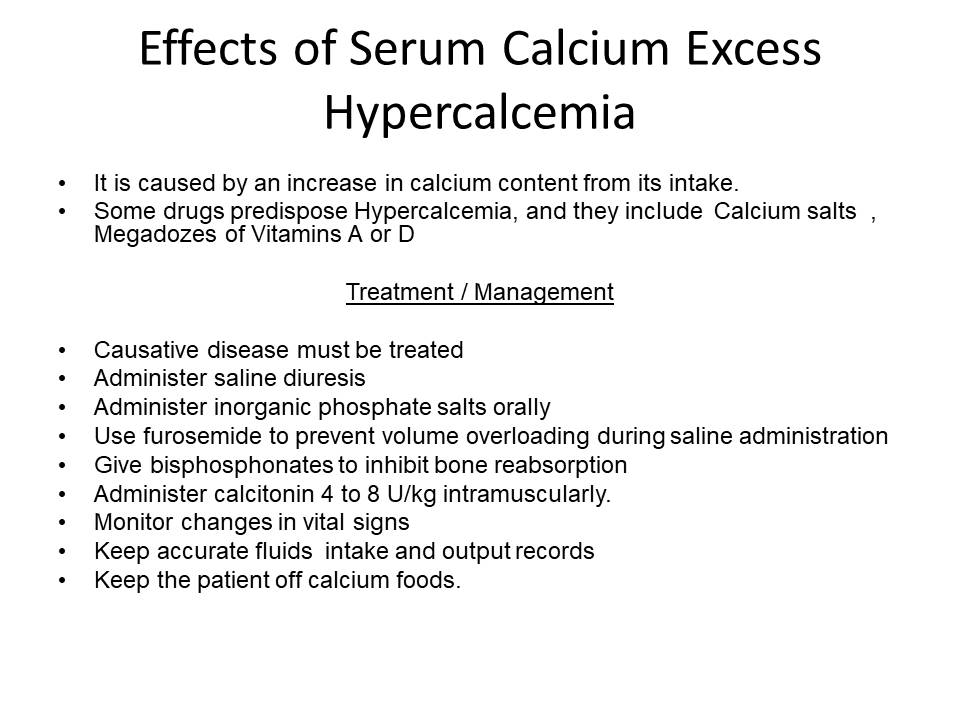
Magnesium (MG++)
Physiologic Roles of Magnesium
- Magnesium influences enzyme action
- It regulates neuromuscular activity
- It regulates electrolyte balance
Effect of Serum magnesium Deficit [ Hypomagnesaemia]
- It occurs when the serum magnesium content drops below 1.0mEq/L
- It can result from chronic alcoholism, prolonged malnutrition , prolonged diarrhea
Clinical Manifestations
- Patients with Hypomagnesaemia show signs of neuromuscular symptoms
- Painful cold hands and feet
- Muscle cramps
- Coarse tremors
Laboratory Findings
- Serum magnesium drops less than 1.5mEq/L
- Urine magnesium helps to identify renal causes of magnesium depletion
- Serum calcium is reduced because of a reduction in the release and action of PTH
Treatments / Management
- Administer oral magnesium salts
- Give 4g diluted in 250mL of 5% dextrose in water at 3mL/min
- Give 1 to 2 g diluted 10mL of 5% dextrose in water by direct I.V push at a rate of 1.5ml/min
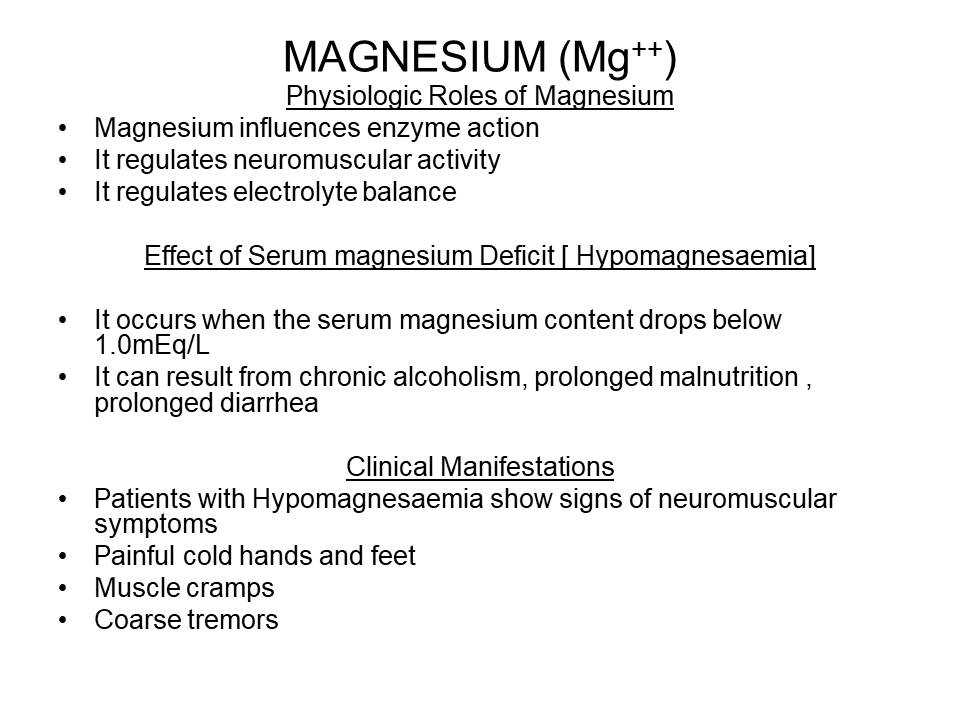
Effect of Excess Serum Magnesium Hypomagnesaemia
- It occurs when the patients serum magnesium is greater than 2.5mEq/L,
- It is caused by renal failure in patients who has increased intake of magnesium
Clinical Manifestations
- It causes depression of peripheral and central neuromuscular transmissions
- Vomiting
- Seizures
- Nausea
Treatment / Management
- The goal is to remove the cause of Hypomagnesaemia avoid using medications containing magnesium
- Administer diuretics and then administer I.V calcium gluconate
- Support respiratory function
- Administer peritoneal or hemodialysis
- Observe for flushing of skin and monitor for ECG changes
- Encourage fluid intake and provide ventilatory assistance
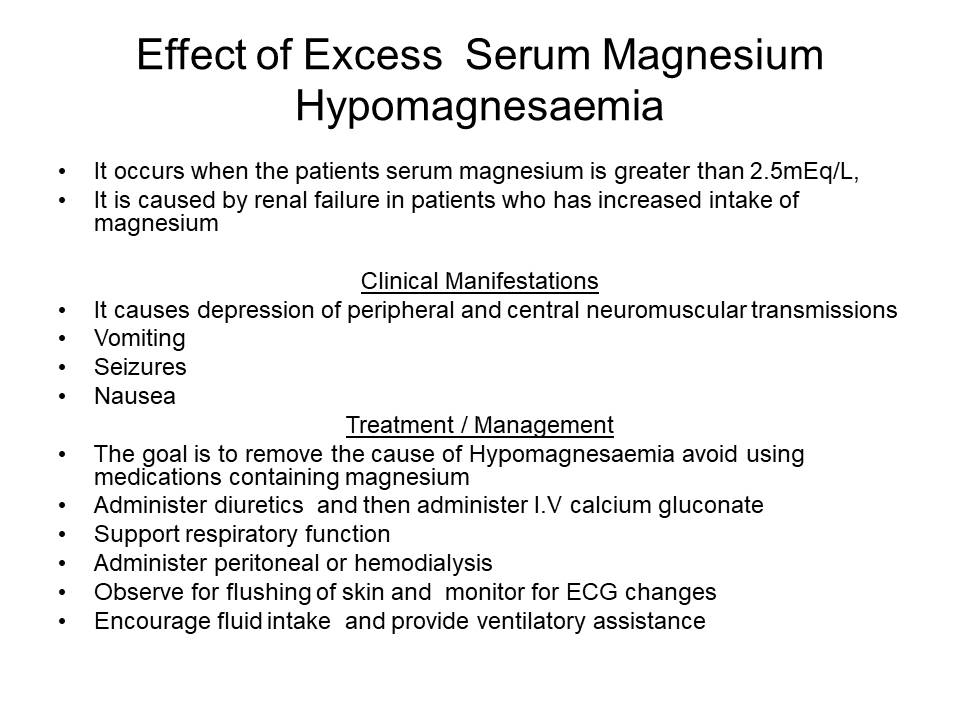
Phosphate (PO4-)
- Phosphorus is essential to all cells
- Influences metabolism
- Essential to energy formation
- It is a cellular building block
- It helps to deliver oxygen
Effects of Serum Phosphate deficit [ Hypophosphatemia]
- When the serum level drops below 2.5mg/dL Hypophosphatemia can occur
Clinical manifestations
- It affects the CNS
- Patients experience disorientation
- Confusion
- Weakness
- Profound muscle weakness
- Congestive cardiomyopathy
Laboratory Findings
- Serum phosphorus drops less than 2.5mg/dL
- Patients show skeletal changes of osteomalacia
- Patients show increase osteoblastic activity
- PTH is elevated
Treatments / Management
- Oral phosphate supplements are given
- Administer I.V sodium phosphorus
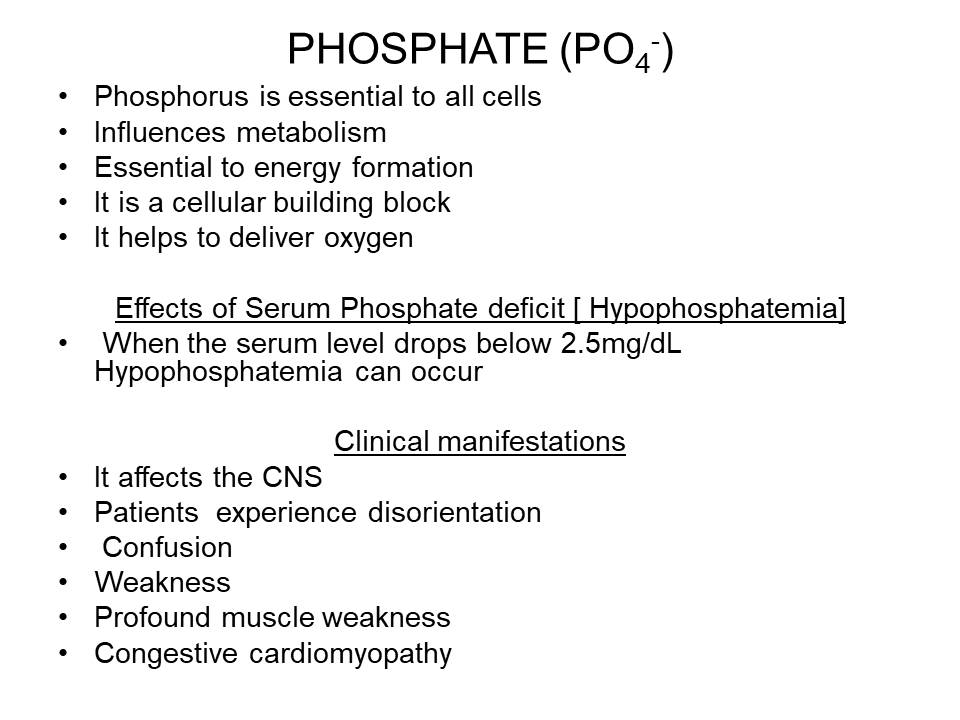
Effects of Serum Phosphate deficit [ Hypophosphatemia]
Hypophosphatemia occurs whenever there is renal insufficiency , hyperparathyroidism, or increased catabolism. This illness can be seen in severe cancer conditions such as myelogenous and lymphoma.
Clinical Manifestations
- Patients with hypophosphatemia experience confusion
- Coma, and increased 2,3- DPG levels in red blood cells
Treatment / Management
- Identify the cause if illness
- Restrict dietary intake
- Administer the intake of phosphate -binding gels
- Monitor for cardiac, GI abnormalities
- Keep accurate records
![Effects of Serum Phosphate deficit [ Hypophosphatemia]](https://ivypanda.com/essays/wp-content/uploads/2022/06/fundamentals-of-fluids-and-electrolytes-balance-slide-14.jpg)
Chloride (CL-)
Physiological Role
- Chloride regulates serum osmolality
- Regulates fluid balance
- Control acidity of gastric juice
- Regulate acid-base balance
- Influences oxygen carbon dioxide exchange

Acid – Base Balance
The regulation of hydrogen ion concentration of body fluids is the key component of acid -base balance.
Three mechanisms operate to maintain the pH of the blood
- Chemical buffer systems in the ECF and within the cells
- Removal of carbon dioxide from the lungs
- Renal regulation of the hydrogen ion concentration
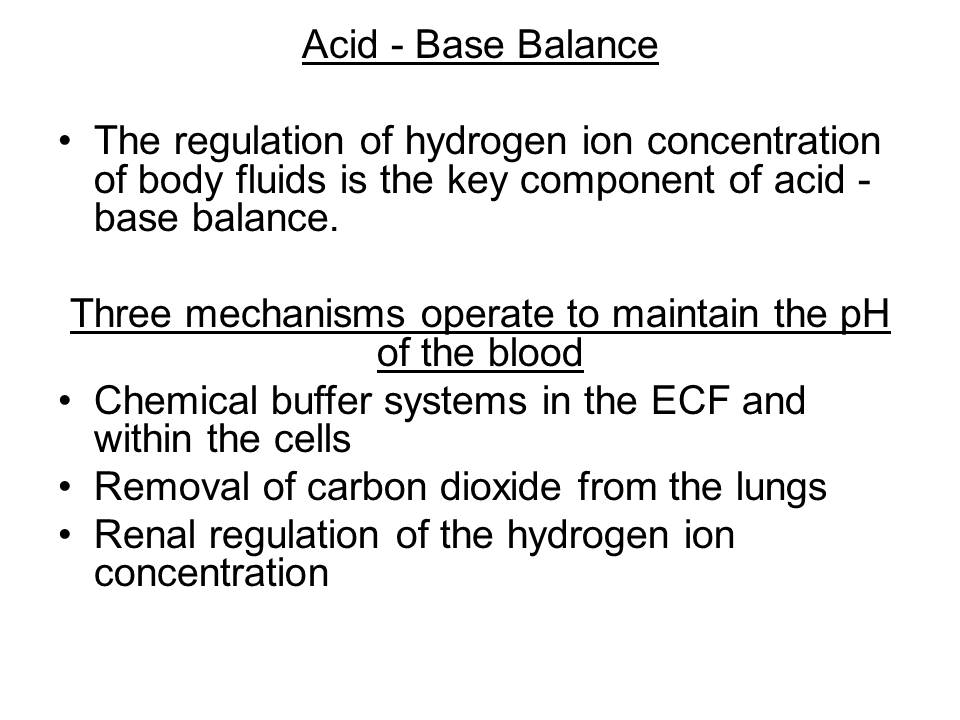
There are two types of Acid -base Imbalance
- Metabolic deficit or excess
- Respiratory deficit or excess
Chemical Buffer Systems
- Buffer systems protect against changes in the hydrogen ion of the ECF
- A buffer is a substance that reacts to minimize pH changes whenever acid or base is released into the system
- Hemoglobin and deoxyhemoglobin acts as buffer pairs together with their potassium salts.
- Plasma proteins act as a buffer
- The bicarbonates buffer system maintains the blood’s pH
- Acid Imbalance occurs when a strong acid is added to the body
Respiratory Regulation
- Lungs form a defense mechanism in maintaining acid – base balance
- Rate of respiration affects the hydrogen ion concentration
- The combination of carbon dioxide with water produces H2CO3so an increase in the acid , lowers the pH of the blood
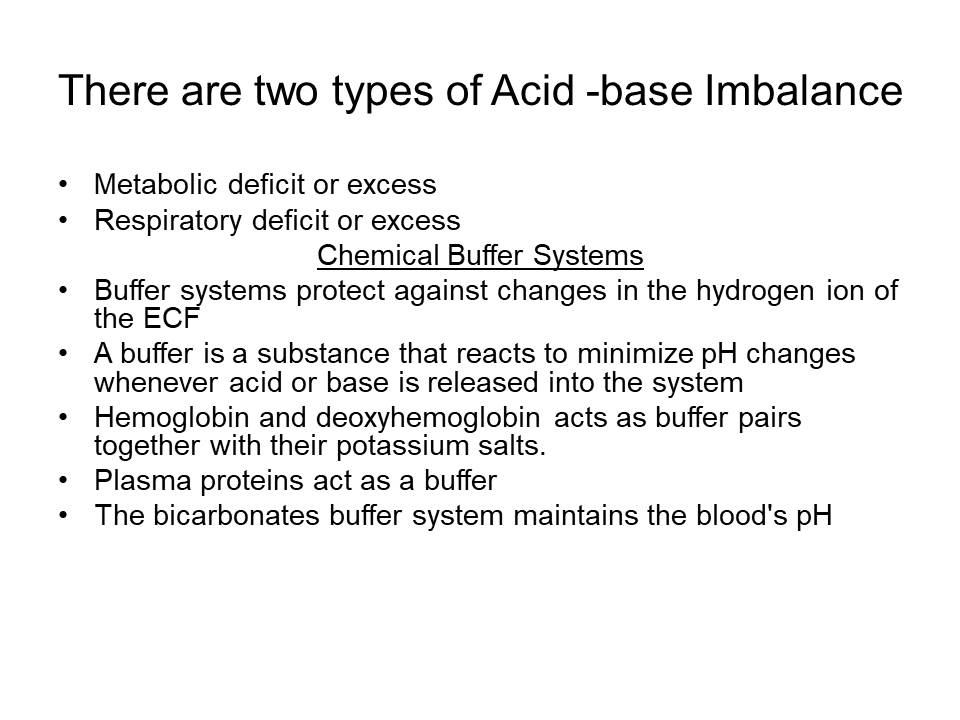
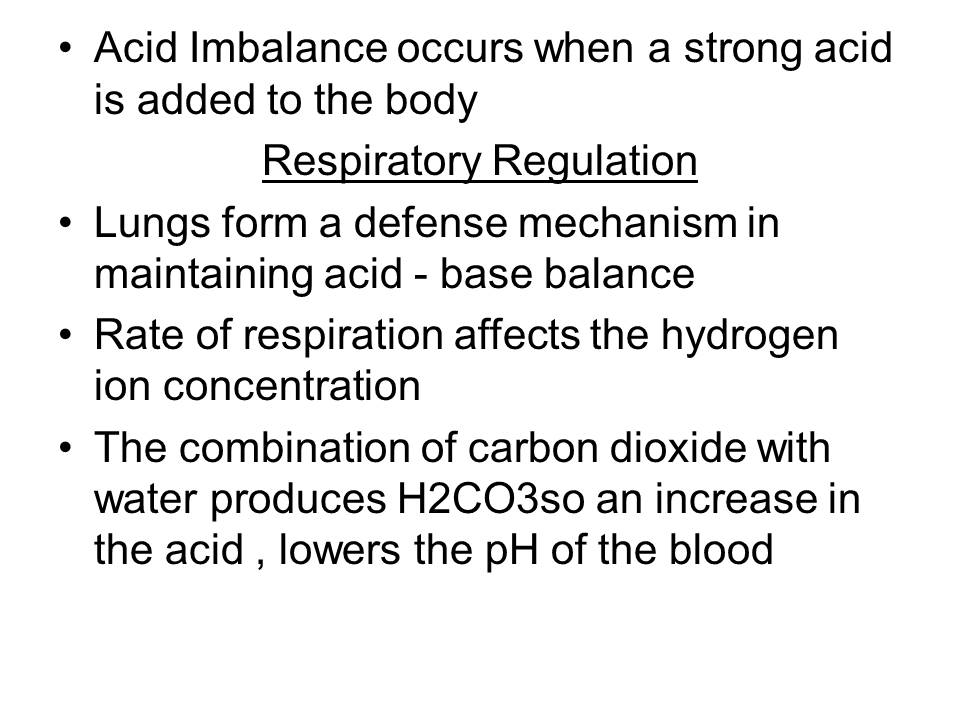
Renal Regulation
- The Kidney regulates the Hydrogen ion by increasing or decreasing HCO3- in the body fluids
- The kidney regulates the extracellular concentration of H2CO3
- Phosphate buffer system and ammonia buffer systems helps the kidney to eliminate excess hydrogen
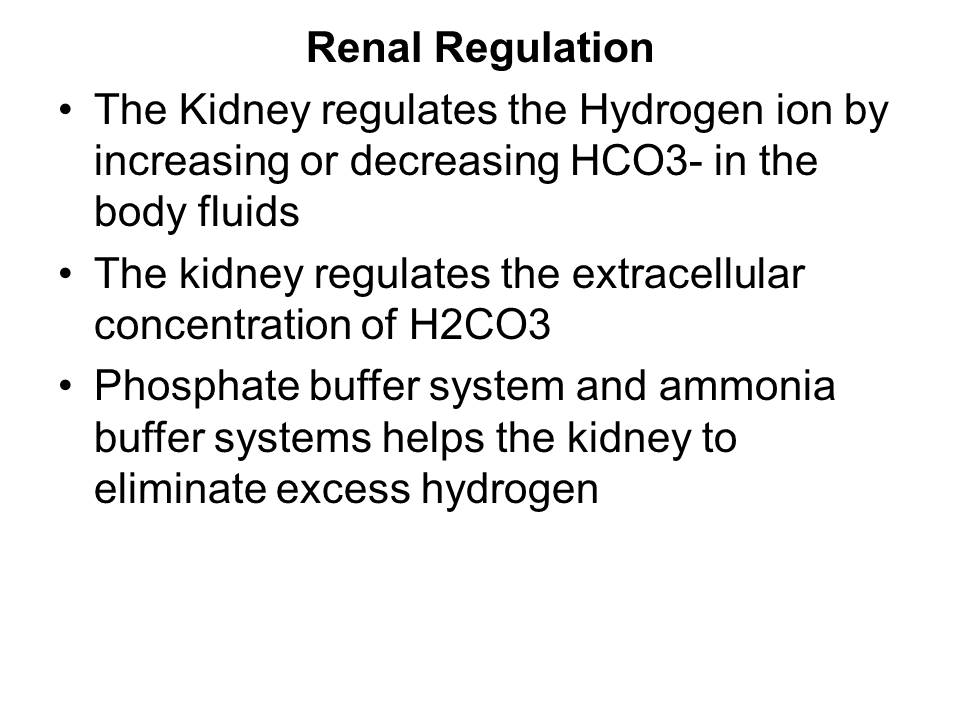
Metabolic Acid- Base Imbalance
- Metabolic Acidosis : Base Bicarbonate Deficit
- Metabolic Acidosis is a clinical disturbance which consist of a low pH and low plasma level
- This condition occurs by a gain of hydrogen ion or a loss
- Occurs with loss of HCO3- from diarrhea, draining fistulas
Clinician manifestations
- Patients experience headache,
- Confusion nausea
- Vomiting
- Increased respiratory rate
Laboratory findings
- ABG values PH less than 7.35
- Paco2 : Less than 38 mm Hg
- Serum electrolytes : Elevated potassium possible
- ECG : Dysrhythmias caused by hyperkalemia
Treatment/ Management
- Reverse underlying cause
- Eliminate the source
- Administer NaHCO3
- Potassium replacement
Key Nursing Interventions
- Provide safety precautions when patient is confused
- Monitor for signs and symptoms of Metabolic Acidosis
- Monitor laboratory changes
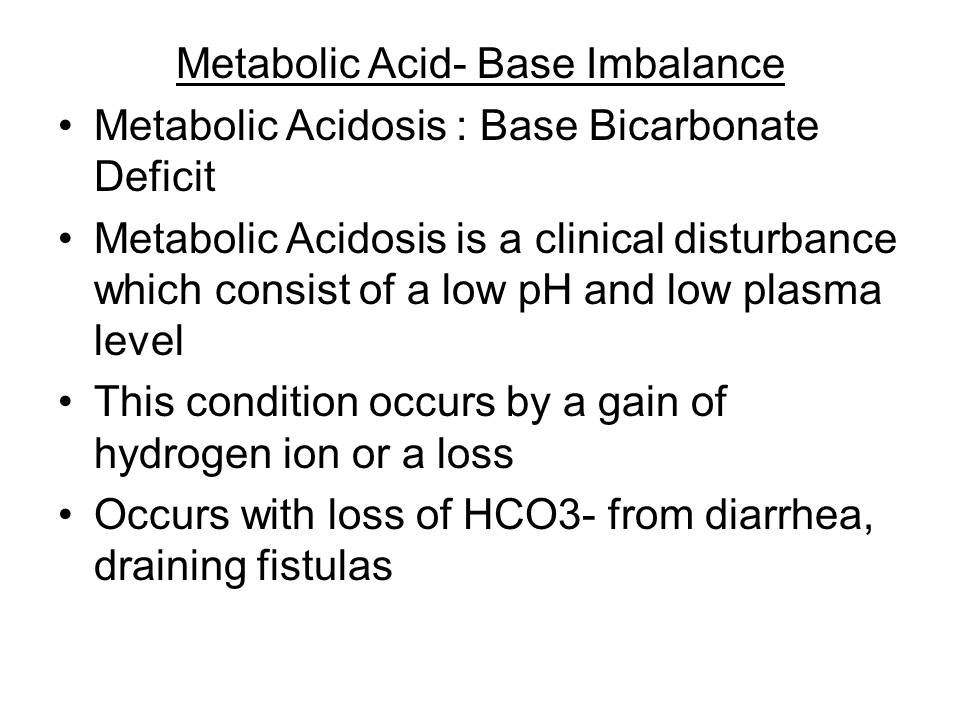
Metabolic Alkalosis : Bicarbonate Excess
- It is a clinical disturbance Characterized by a high pH and high Plasma and can be
- Produced by the gain or loss of hydrogen ion
- It occurs with GI loss of hydrogen ions from gastric suction and vomiting.
- Occurs when excessive ingestion of alkalis
Clinical Manifestations
- Dizziness and depressed respirations
- Hyperventilation
Laboratory findings
- ABG values pH greater than 7.45
- Low serum potassium
- Low serum chloride
Treatment / Management
- Reverse the cause
- Administer sufficient chloride for the kidney to excrete the excess ion
- Replace hydrogen
- Carbonic anhydrase inhibitors
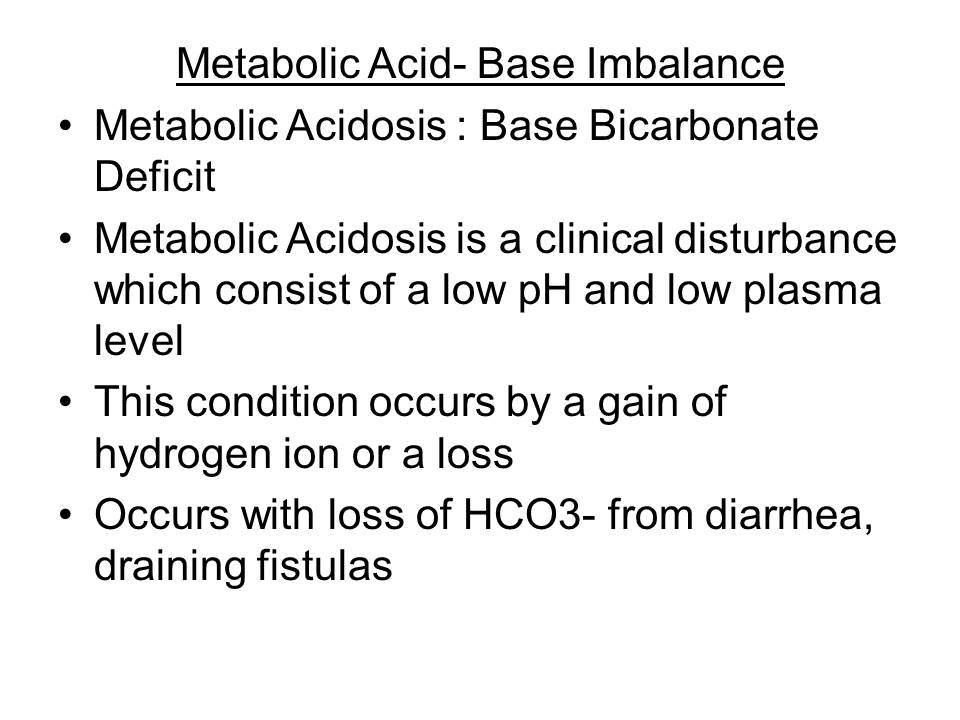
Metabolic Alkalosis : Bicarbonate Excess
- It is a clinical disturbance Characterized by a high pH and high Plasma and can be
- Produced by the gain or loss of hydrogen ion
- It occurs with GI loss of hydrogen ions from gastric suction and vomiting.
- Occurs when excessive ingestion of alkalis
Clinical Manifestations
- Dizziness and depressed respirations
- Hyperventilation
Laboratory findings
- ABG values pH greater than 7.45
- Low serum potassium
- Low serum chloride
Treatment / Management
- Reverse the cause
- Administer sufficient chloride for the kidney to excrete the excess ion
- Replace hydrogen
- Carbonic anhydrase inhibitors
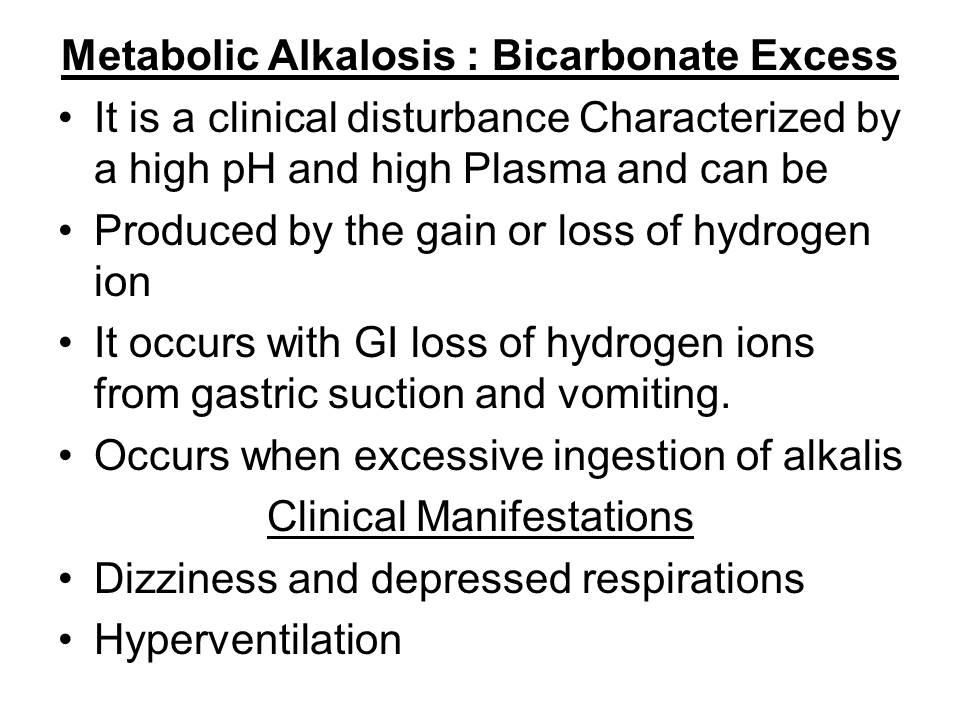
Respiratory Acidosis : carbonic Acid Excess
- Caused by inadequate excretion of carbon dioxide and inadequate ventilation
- Chronic respiratory acidosis results from obesity, and tight abdominal binders
Clinical Manifestations
- Dizziness
- Flushed skin
- Ventricular fibrillation
Nursing process
- It is a five or six step process for problem solving
- Laboratory findings
- ABG values pH less than 7.35
- Serum electrolytes not altered
- Drug screen
Treatment / Management
- Restore normal acid -base balance
- Administer bronchodilators or antibiotics
- Administer oxygen and adequate fluids
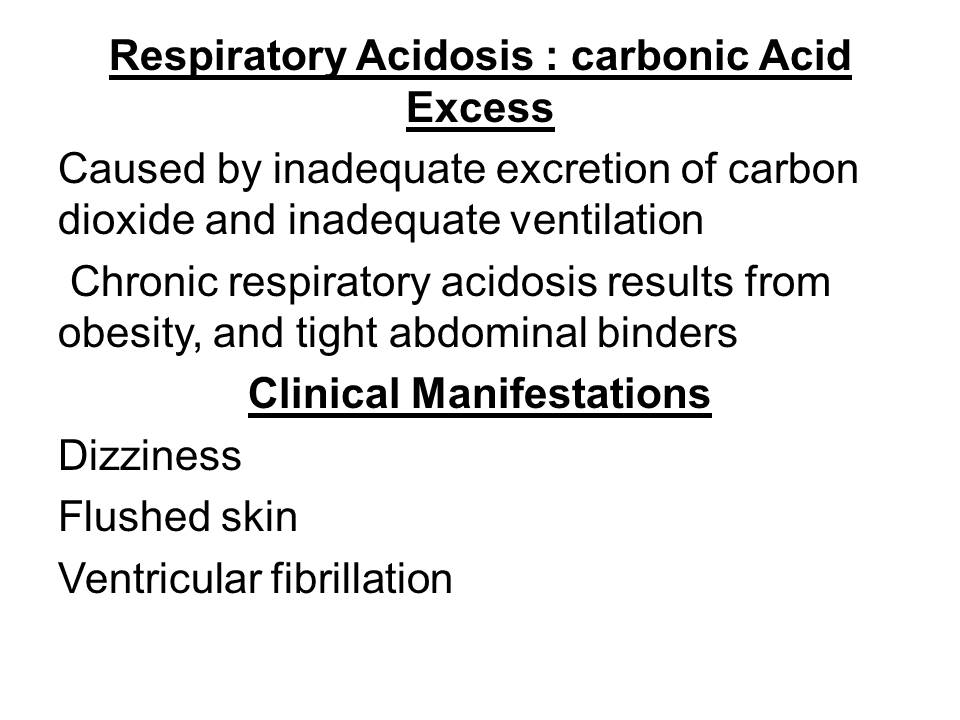
Respiratory Alkalosis : Carbonic Acid Deficit
- Caused by hyperventilation which causes blowing off of carbon dioxide and a
- Decrease in hydrogen ion content
- Caused by congestive heart failure, asthma,
- Inhalation of irritants
Clinical manifestations
- Cause light- headedness
- Inability to concentrate
- Blurred vision, seizures, loss of consciousness
Treatment/ Management
- Treat source of anxiety
- Administer a sedative as indicated
- Oxygen therapy
- Adjust ventilators
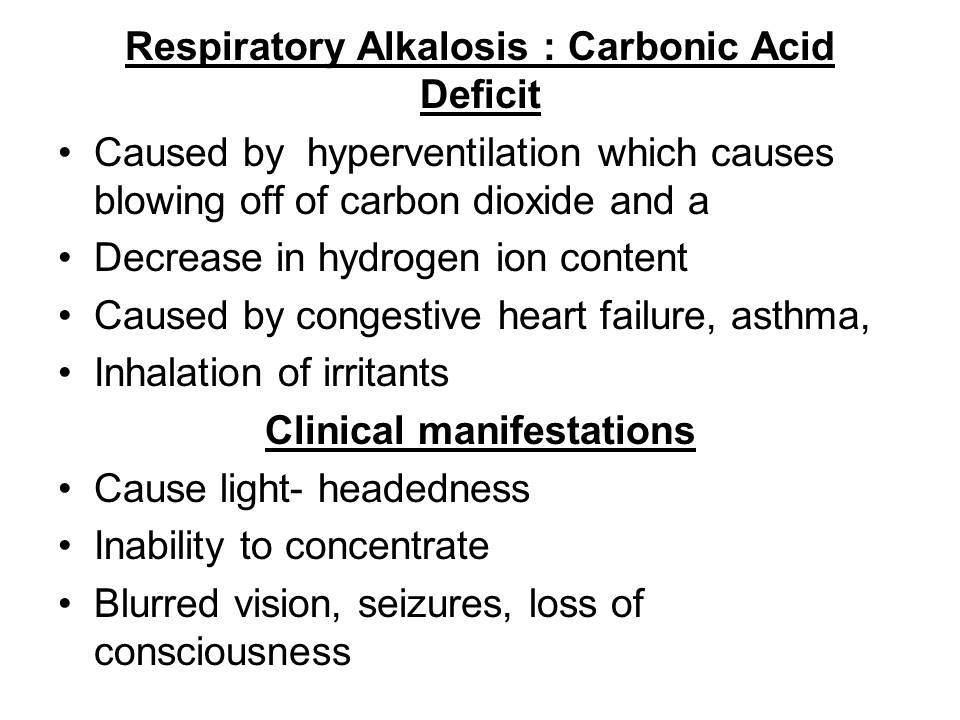
Case Study 2
The 28 year old woman lost 9.2% of her body weight upon admissionю
Laboratory Findings include
- Drop in serum potassium level
- Increased pH and bicarbonate ions [ Arterial blood gas]
- Increase insulin secretion and osmotic pressure
- Depression
Nursing Interventions
- This treatment must be administered slowly to watch for dysrhythmias
- Potassium replacement can be by mouth or intravenous
- Salt substitutes can be used
- Never give a potassium I.V. push/Bolus
- Make sure the test results are carefully examined
- Monitor signs and symptoms of hypokalemia
- Monitor changes in cardiac arrest
- Never administer potassium by I.V push
